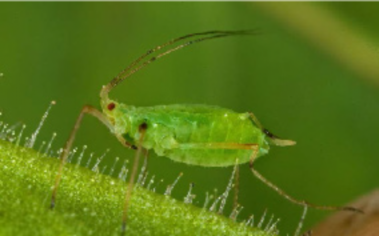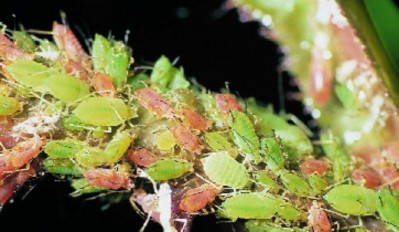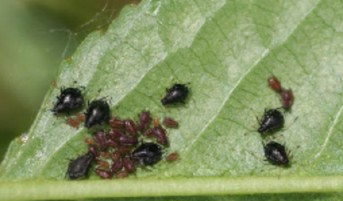Aphids (Scientific Name: Family Aphididae)

Figure 1. Rose aphids. G. Csoka, HFRI, Bugwood.org

Figure 2. Green peach aphids. D. Cappaert, Bugwood.

Figure 3. Black cherry aphids. W. Cranshaw, CSU, Bugwood
Hosts
Several hosts.
Damage and Symptoms
Aphids are sap-sucking insects and the saliva they release from feeding can cause discoloring, curling, distortion, or overall lack of vigor.
Life Cycle
Aphids overwinter primarily in the egg stage on a particular host and reproduce in large numbers asexually (absence of males) during the growing season. Later in the summer, most aphids produce winged generations and move to a second host. In the fall, they return to their primary host, mate, and lay eggs.
Management
A strong spray of water alone can often remove aphids. Aphid populations tend to be higher in plants that are fertilized liberally with nitrogen, as this produces flushes of succulent growth. Avoid excessive watering, and use slow-release fertilizers. There are a variety of relatively low toxicity contact products including soaps, oils, and botanicals. Good coverage with contact pesticides is essential. Systemic insecticides (insecticides taken up through the root system) are particularly useful when contact is difficult and to protect new growth over time (active ingredients such as imidacloprid, dinotefuran). Broad-spectrum insecticides are generally less integrated pest management (IPM) compatible.
Further Information
To learn more about the topics discussed on this page, contact the Schutter Diagnostic Lab. If you suspect an infestation on your property, contact your local extension agent, the Schutter Diagnostic Lab at Montana State University, or the Montana Department of Agriculture.
This August 2021 fact sheet is also available as a printable PDF (155KB).
Disclaimer: These recommendations are provided only as a guide. It is always the pesticide applicator’s responsibility, by law, to read and follow all current label directions for the specific pesticide being used. The authors and Montana State University assume no liability resulting from the use of these recommendations. The Montana State University Extension Service is an ADA/EO/AA/Veteran’s Preference Employer and Provider of Educational Outreach.
